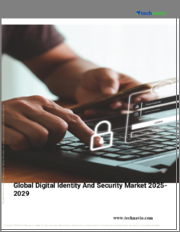
|
시장보고서
상품코드
1609703
일본의 보안 시장 보고서 : 시스템, 서비스, 최종 사용자, 지역별(2025-2033년)Japan Security Market Report by System, Service, End User, and Region 2025-2033 |
||||||
일본의 보안 시장 규모는 2024년 37억 달러로 추정됩니다. 향후 IMARC Group은 이 시장이 2033년까지 78억 달러에 이르고, 2025-2033년간 연평균 성장률(CAGR)은 8.7%를 나타낼 것으로 예상하고 있습니다. 지속적인 기술 발전, 보안 위협에 대한 소비자의 인식 증가, 규제 기준의 진화, 급속한 도시화, 인프라 개발 확대 등이 시장을 주도하는 주요 요인으로 꼽힙니다.
본 보고서에서 다룬 주요 질문
- 일본의 보안 시장은 지금까지 어떻게 발전해 왔으며, 앞으로 어떻게 발전할 것인가?
- 코로나19가 일본 보안 시장에 미친 영향은?
- 일본 보안 시장의 시스템별 시장 현황은?
- 일본 보안 시장의 서비스별 현황은?
- 일본 보안 시장의 최종 사용자별 현황은?
- 일본 보안 시장의 밸류체인에는 어떤 단계가 있는가?
- 일본 보안 시장의 주요 촉진요인과 과제는?
- 일본 보안 시장의 구조와 주요 기업은?
- 일본 보안 시장의 경쟁은 어느 정도인가?
목차
제1장 서문
제2장 조사 범위와 조사 방법
- 조사 목적
- 이해관계자
- 데이터 소스
- 시장 추정
- 조사 방법
제3장 주요 요약
제4장 일본의 보안 시장 : 서론
- 개요
- 시장 역학
- 업계 동향
- 경쟁 정보
제5장 일본의 보안 시장 구도
- 과거 및 현재 시장 동향(2019-2024년)
- 시장 예측(2025-2033년)
제6장 일본의 보안 시장 : 시스템별 분석
- 액세스 제어 시스템
- 경보 및 통지 시스템
- 침입 감지 시스템
- 비디오 감시 시스템
- 배리어 시스템
- 기타
제7장 일본의 보안 시장 : 서비스별 분석
- 시스템 통합 및 컨설팅
- 리스크 평가 및 분석
- 매니지드 서비스
- 유지관리 및 지원
제8장 일본의 보안 시장 : 최종사용자별 분석
- 정부
- 군 및 방위
- 운송
- 상업
- 산업
- 기타
제9장 일본의 보안 시장 : 경쟁 구도
- 개요
- 시장 구조
- 시장 기업 포지셔닝
- 주요 성공 전략
- 경쟁 대시보드
- 기업 평가 상한
제10장 주요 기업 개요
제11장 일본의 보안 시장 - 업계 분석
- 성장 촉진요인 및 억제요인과 기회
- Porter의 Five Forces 분석
- 밸류체인 분석
제12장 부록
LSH 24.12.23The Japan security market size reached USD 3.7 Billion in 2024. Looking forward, IMARC Group expects the market to reach USD 7.8 Billion by 2033, exhibiting a growth rate (CAGR) of 8.7% during 2025-2033. Ongoing technological advancement, escalating consumer awareness regarding security threats, evolving regulatory norms, rapid urbanization, and expanding infrastructural development, represent some of the key factors driving the market.
Security refers to the protection measures taken to safeguard an entity, whether it's an individual, a business, or a nation, from threats and potential harm. It involves employing specific strategies, technologies, and procedures to prevent unauthorized access, damage, or theft of assets. These assets could be physical, such as buildings or equipment, or intangible, like information or intellectual property. In the contemporary digital world, cybersecurity has become particularly crucial, given the escalating risks of data breaches, identity theft, and cyberattacks. Businesses, in particular, recognize the critical importance of robust security practices for the preservation of their resources, reputation, and operational stability. These practices span from ensuring the physical safety of their premises and employees to protecting their digital assets, such as sensitive customer data and proprietary information. This is often achieved through a combination of technical measures, such as firewalls and encryption, and policy-based approaches, such as employee training and access control measures. From an individual perspective, security measures ensure personal safety and safeguard privacy. Security is a comprehensive framework aimed at risk management and threat mitigation, fundamental to sustaining a safe and stable environment, whether in personal, professional, or national contexts.
Japan Security Market Trends:
The growth of the security market in Japan is primarily driven by the rise of advanced technologies including artificial intelligence (AI), Internet of Things (IoT), and cloud computing. These technologies allow for more proactive and sophisticated security solutions, offering real-time response capabilities, and the ability to anticipate potential threats, a feature increasingly in demand in both physical and cyber security domains. In addition to this, the escalating awareness and concern over cyber threats, driven by several high-profile cyber-attacks, have led to increased investments in cybersecurity solutions as businesses are prioritizing the protection of their data and IT infrastructure to ensure operational continuity and safeguard their reputation, creating a favorable outlook for market expansion. Moreover, the stringent regulatory framework of Japan mandating businesses to adopt certain security measures to protect customer data and privacy is presenting remunerative growth opportunities for the market. Furthermore, there is a surging demand for secure smart city solutions and comprehensive security systems, which is strengthening the market growth. Concurrent with this, the aging population of Japan is leading to the growth of the personal security and surveillance systems market.
Japan Security Industry Segmentation:
Breakup by System:
Access Control Systems
Alarms and Notification Systems
Intrusion Detection Systems
Video Surveillance Systems
Barrier Systems
Others
Breakup by Service:
System Integration and Consulting
Risk Assessment and Analysis
Managed Services
Maintenance and Support
Breakup by End User:
Government
Military and Defense
Transportation
Commercial
Industrial
Others
Competitive Landscape:
The report has also provided a comprehensive analysis of the competitive landscape in the Japan security market. Competitive analysis such as market structure, key player positioning, top winning strategies, competitive dashboard, and company evaluation quadrant has been covered in the report. Also, detailed profiles of all major companies have been provided.
Key Questions Answered in This Report:
- How has the Japan security market performed so far and how will it perform in the coming years?
- What has been the impact of COVID-19 on the Japan security market?
- What is the breakup of the Japan security market on the basis of the system?
- What is the breakup of the Japan security market on the basis of service?
- What is the breakup of the Japan security market on the basis of end user?
- What are the various stages in the value chain of the Japan security market?
- What are the key driving factors and challenges in the Japan security market?
- What is the structure of the Japan security market and who are the key players?
- What is the degree of competition in the Japan security market?
Table of Contents
1 Preface
2 Scope and Methodology
- 2.1 Objectives of the Study
- 2.2 Stakeholders
- 2.3 Data Sources
- 2.3.1 Primary Sources
- 2.3.2 Secondary Sources
- 2.4 Market Estimation
- 2.4.1 Bottom-Up Approach
- 2.4.2 Top-Down Approach
- 2.5 Forecasting Methodology
3 Executive Summary
4 Japan Security Market - Introduction
- 4.1 Overview
- 4.2 Market Dynamics
- 4.3 Industry Trends
- 4.4 Competitive Intelligence
5 Japan Security Market Landscape
- 5.1 Historical and Current Market Trends (2019-2024)
- 5.2 Market Forecast (2025-2033)
6 Japan Security Market - Breakup by System
- 6.1 Access Control Systems
- 6.1.1 Overview
- 6.1.2 Historical and Current Market Trends (2019-2024)
- 6.1.3 Market Forecast (2025-2033)
- 6.2 Alarms and Notification Systems
- 6.2.1 Overview
- 6.2.2 Historical and Current Market Trends (2019-2024)
- 6.2.3 Market Forecast (2025-2033)
- 6.3 Intrusion Detection Systems
- 6.3.1 Overview
- 6.3.2 Historical and Current Market Trends (2019-2024)
- 6.3.3 Market Forecast (2025-2033)
- 6.4 Video Surveillance Systems
- 6.4.1 Overview
- 6.4.2 Historical and Current Market Trends (2019-2024)
- 6.4.3 Market Forecast (2025-2033)
- 6.5 Barrier Systems
- 6.5.1 Overview
- 6.5.2 Historical and Current Market Trends (2019-2024)
- 6.5.3 Market Forecast (2025-2033)
- 6.6 Others
- 6.6.1 Historical and Current Market Trends (2019-2024)
- 6.6.2 Market Forecast (2025-2033)
7 Japan Security Market - Breakup by Service
- 7.1 System Integration and Consulting
- 7.1.1 Overview
- 7.1.2 Historical and Current Market Trends (2019-2024)
- 7.1.3 Market Forecast (2025-2033)
- 7.2 Risk Assessment and Analysis
- 7.2.1 Overview
- 7.2.2 Historical and Current Market Trends (2019-2024)
- 7.2.3 Market Forecast (2025-2033)
- 7.3 Managed Services
- 7.3.1 Overview
- 7.3.2 Historical and Current Market Trends (2019-2024)
- 7.3.3 Market Forecast (2025-2033)
- 7.4 Maintenance and Support
- 7.4.1 Overview
- 7.4.2 Historical and Current Market Trends (2019-2024)
- 7.4.3 Market Forecast (2025-2033)
8 Japan Security Market - Breakup by End User
- 8.1 Government
- 8.1.1 Overview
- 8.1.2 Historical and Current Market Trends (2019-2024)
- 8.1.3 Market Forecast (2025-2033)
- 8.2 Military and Defense
- 8.2.1 Overview
- 8.2.2 Historical and Current Market Trends (2019-2024)
- 8.2.3 Market Forecast (2025-2033)
- 8.3 Transportation
- 8.3.1 Overview
- 8.3.2 Historical and Current Market Trends (2019-2024)
- 8.3.3 Market Forecast (2025-2033)
- 8.4 Commercial
- 8.4.1 Overview
- 8.4.2 Historical and Current Market Trends (2019-2024)
- 8.4.3 Market Forecast (2025-2033)
- 8.5 Industrial
- 8.5.1 Overview
- 8.5.2 Historical and Current Market Trends (2019-2024)
- 8.5.3 Market Forecast (2025-2033)
- 8.6 Others
- 8.6.1 Historical and Current Market Trends (2019-2024)
- 8.6.2 Market Forecast (2025-2033)
9 Japan Security Market - Competitive Landscape
- 9.1 Overview
- 9.2 Market Structure
- 9.3 Market Player Positioning
- 9.4 Top Winning Strategies
- 9.5 Competitive Dashboard
- 9.6 Company Evaluation Quadrant
10 Profiles of Key Players
- 10.1 Company A
- 10.1.1 Business Overview
- 10.1.2 Product Portfolio
- 10.1.3 Business Strategies
- 10.1.4 SWOT Analysis
- 10.1.5 Major News and Events
- 10.2 Company B
- 10.2.1 Business Overview
- 10.2.2 Product Portfolio
- 10.2.3 Business Strategies
- 10.2.4 SWOT Analysis
- 10.2.5 Major News and Events
- 10.3 Company C
- 10.3.1 Business Overview
- 10.3.2 Product Portfolio
- 10.3.3 Business Strategies
- 10.3.4 SWOT Analysis
- 10.3.5 Major News and Events
- 10.4 Company D
- 10.4.1 Business Overview
- 10.4.2 Product Portfolio
- 10.4.3 Business Strategies
- 10.4.4 SWOT Analysis
- 10.4.5 Major News and Events
- 10.5 Company E
- 10.5.1 Business Overview
- 10.5.2 Product Portfolio
- 10.5.3 Business Strategies
- 10.5.4 SWOT Analysis
- 10.5.5 Major News and Events
11 Japan Security Market - Industry Analysis
- 11.1 Drivers, Restraints, and Opportunities
- 11.1.1 Overview
- 11.1.2 Drivers
- 11.1.3 Restraints
- 11.1.4 Opportunities
- 11.2 Porters Five Forces Analysis
- 11.2.1 Overview
- 11.2.2 Bargaining Power of Buyers
- 11.2.3 Bargaining Power of Suppliers
- 11.2.4 Degree of Competition
- 11.2.5 Threat of New Entrants
- 11.2.6 Threat of Substitutes
- 11.3 Value Chain Analysis



















